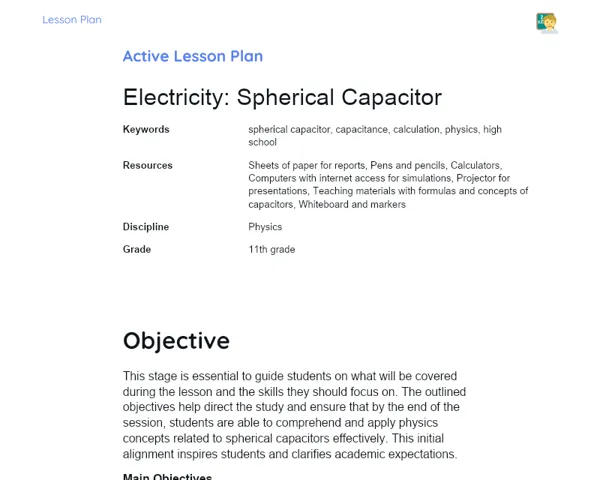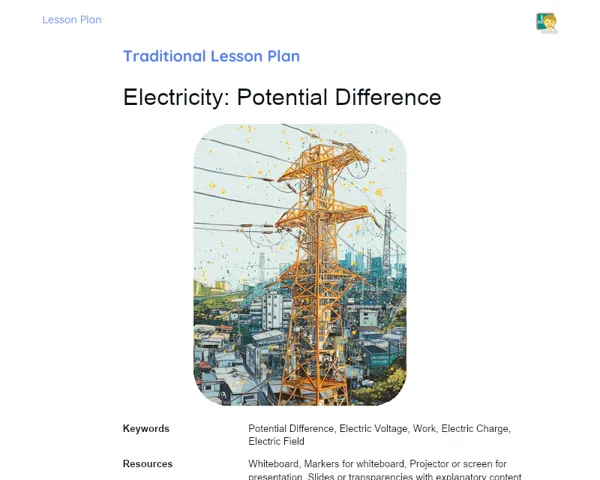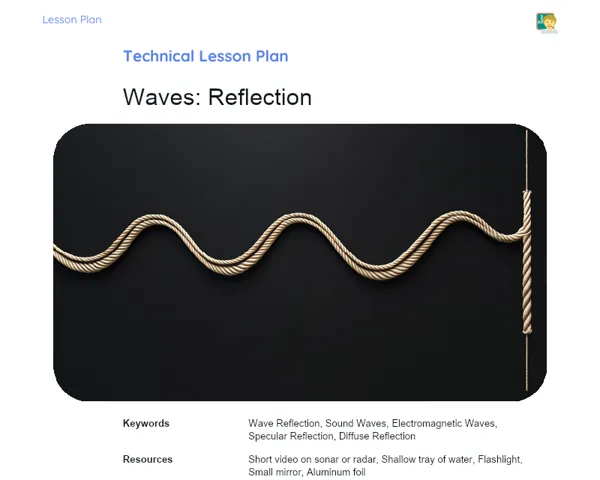Lesson Plan Teknis | Waves: Doppler Effect
| Palavras Chave | Doppler Effect, Apparent frequency, Sound source, Moving observer, Ultrasound, Astronomy, Radar technology, Hands-on simulation, Maker activity, Frequency calculation |
| Materiais Necessários | Cellphone with a continuous sound app, Toy car, Tape, Ruler, Short video demonstrating the Doppler Effect |
Objective
Duration: (10 - 15 minutes)
The aim of this stage is to clarify the lesson objectives, ensuring that students appreciate the significance of learning about the Doppler Effect. This includes the ability to calculate apparent frequencies, which is a useful skill for academic pursuits and career opportunities in fields like sound engineering, healthcare (ultrasound), and astronomy (studying star spectra).
Objective Utama:
1. Comprehend the concept of the Doppler Effect and its practical applications.
2. Calculate the apparent frequency perceived by an observer in varying scenarios of relative motion between the sound source and the observer.
Objective Sampingan:
- Enhance problem-solving abilities related to complex relative motion.
- Utilize theoretical knowledge in hands-on activities that mirror real-world situations.
Introduction
Duration: (15 - 20 minutes)
The goal of this stage is to introduce the Doppler Effect concept engagingly, connecting it to everyday experiences and its practical uses. This approach helps students see the topic's relevance, igniting their interest and preparing them for the forthcoming practical and theoretical tasks.
Curiosities and Market Connection
Healthcare: The Doppler Effect plays a key role in Doppler ultrasounds to track blood flow in various body areas, aiding in the diagnosis of issues like blood clots and venous insufficiency. Astronomy: Astronomers employ the Doppler Effect to gauge the velocity of stars and galaxies as they relate to Earth, helping enhance our understanding of the universe's expansion. Radar Technology: Radar and sonar technologies leverage the Doppler Effect to ascertain the speed of moving entities, which is crucial for air and maritime navigation.
Contextualization
The Doppler Effect, first identified by Austrian physicist Christian Doppler in 1842, is something we've all encountered, often without knowing it. Think about an ambulance zooming by with its siren on: the sound appears higher in pitch as it approaches you and drops when it moves away. This phenomenon isn't exclusive to sound; it also applies to light waves, enabling astronomers to ascertain whether stars and galaxies are drifting closer to or farther from Earth. Grasping the Doppler Effect is vital across multiple domains, including healthcare where it's used in ultrasound technology, as well as in radar and sonar advancements.
Initial Activity
Short Video: Show a brief video (2-3 minutes) that illustrates the Doppler Effect in action, such as the sound of a passing ambulance or a demonstration of a Doppler ultrasound. Provocative Question: Engage students with the question: "How do you think the sound of an ambulance changes while it approaches and moves away from us? What causes this?" Encourage lively discussion in small groups before sharing insights with the class.
Development
Duration: (45 - 50 minutes)
This stage aims to deepen students' comprehension of the Doppler Effect through an effective mix of theory and practice. The hands-on activity is designed to give them a real experience of this phenomenon, while fixing exercises and evaluations guarantee a solid understanding of the theory and proper application of the formulas involved.
Topics
1. Understanding the Doppler Effect
2. Formula for the Doppler Effect in sound waves
3. Real-life applications of the Doppler Effect
4. Examples of calculating apparent frequency
Thoughts on the Subject
Encourage students to think about how they notice the Doppler Effect in their daily environment, like the sound of an ambulance or the siren of a moving police vehicle. Provoking them to consider the implications of this phenomenon in different scientific and technological fields, and how the knowledge of this effect has practical applications in professions ranging from healthcare to astronomy.
Mini Challenge
Simulating the Doppler Effect with Moving Source and Observer
In this activity, students will carry out a hands-on simulation using everyday materials to explore the Doppler Effect. They will create a setup with a sound source (like a cellphone playing continuous sound) and a moving observer (using a toy car).
1. Divide students into groups of 3-4 members.
2. Distribute the required materials: a cellphone with a continuous sound app, a toy car, tape, and a ruler.
3. Instruct the groups to secure the cellphone to the toy car using tape.
4. Ask students to switch on the continuous sound on the cellphone and move the car (sound source) towards and then away from the observer.
5. Request students to observe and record the changes in sound frequency experienced by the observer in both scenarios.
6. Guide them to calculate the apparent frequency using the Doppler Effect formula for sound waves and compare it with their observations.
To understand practically how relative motion between the sound source and observer influences the perceived frequency of sound, applying the Doppler Effect formula to calculate the apparent frequency.
**Duration: (25 - 30 minutes)
Evaluation Exercises
1. Calculate the apparent frequency perceived by a stationary observer as a sound source travels towards them at a speed of 20 m/s. Assume the initial frequency of the source is 500 Hz and the speed of sound in air is 340 m/s.
2. A police vehicle shares a siren sound at a frequency of 700 Hz while moving away from an observer at a speed of 25 m/s. Determine the apparent frequency perceived by the observer. Consider the speed of sound in air as 340 m/s.
3. Explain the role of the Doppler Effect in healthcare for monitoring blood flow using Doppler ultrasounds.
4. Describe how astronomers leverage the Doppler Effect to measure the speeds of stars and galaxies in relation to Earth.
Conclusion
Duration: (10 - 15 minutes)
The purpose of this stage is to reinforce students' understanding, ensuring they appreciate the significance of the Doppler Effect from both theoretical and practical angles. This phase enables students to reflect on the activities conducted, linking their acquired knowledge to everyday contexts and acknowledging the relevance of the subject in their future professions.
Discussion
Facilitate a concluding discussion with students, prompting them to reflect on the mini-challenges and exercises undertaken. Query how they experienced the practical application of the Doppler Effect during the activities, and motivate them to share their observations and calculations. Encourage them to consider other daily scenarios or sectors where the Doppler Effect might hold significance, reinforcing the interdisciplinary essence of the topic.
Summary
Summarise the key concepts covered in the lesson: the Doppler Effect's nature, how it is perceived in different contexts, and the mathematical formula for approximating apparent frequency. Stress the integration of theoretical and practical knowledge of the phenomenon, highlighting specific examples and calculations shared by the students.
Closing
Clarify how the lesson bridged theory and practice, showcasing the importance of the Doppler Effect in various fields like healthcare, astronomy, and radar technology. Highlight the necessity of the knowledge gained for understanding physical phenomena in everyday life and its relevance in the job market. Conclude by expressing gratitude for everyone's engagement and underlining the significance of science in tackling real-world challenges.



